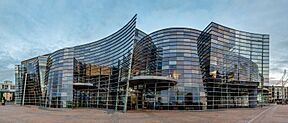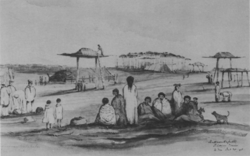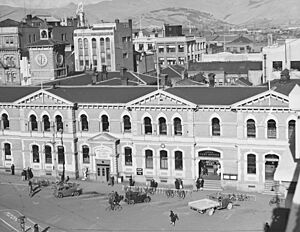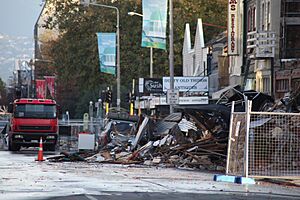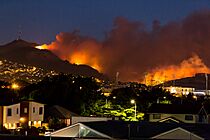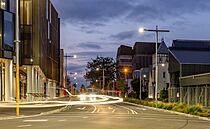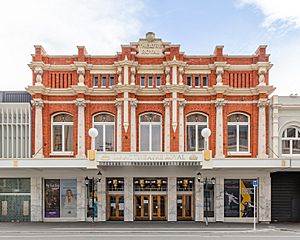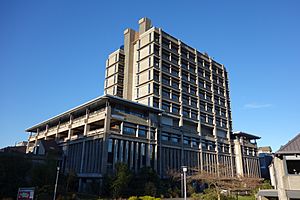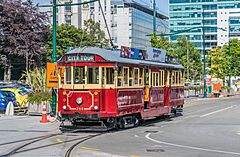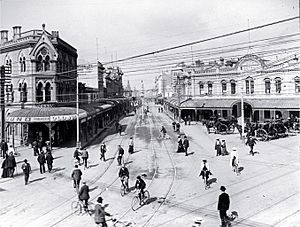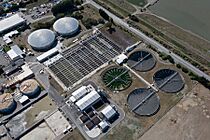Christchurch facts for kids
Quick facts for kids
Christchurch
Ōtautahi (Māori)
|
|||||
|---|---|---|---|---|---|
|
Christchurch Central City (2020)
Sumner and Southshore
|
|||||
|
|||||
| Nickname(s):
The Garden City
|
|||||
| Motto(s):
Fide Condita Fructu Beata Spe Fortis
English: Founded in Faith, Rich in the Fulfillment thereof, Strong in Hope for the Future |
|||||
| Country | New Zealand | ||||
| Island | South Island | ||||
| Region | Canterbury | ||||
| Communities |
|
||||
| Wards |
|
||||
| Settled by the UK | 1848 | ||||
| Named for | Christ Church, Oxford | ||||
| NZ Parliament | Banks Peninsula Christchurch Central Christchurch East Ilam Selwyn Waimakariri Wigram Te Tai Tonga (Māori) |
||||
| Area | |||||
| • Territorial | 1,426 km2 (551 sq mi) | ||||
| • Land | 1,415.15 km2 (546.39 sq mi) | ||||
| • Urban | 294.43 km2 (113.68 sq mi) | ||||
| • Metro | 2,408.1 km2 (929.8 sq mi) | ||||
| Elevation | 6 m (20 ft) | ||||
| Population
(June 2023)
|
|||||
| • Territorial | 396,200 | ||||
| • Density | 277.84/km2 (719.6/sq mi) | ||||
| • Urban | 384,800 | ||||
| • Urban density | 1,306.93/km2 (3,384.9/sq mi) | ||||
| • Metro | 521,881 | ||||
| • Metro density | 216.719/km2 (561.300/sq mi) | ||||
| • Demonym | Cantabrian | ||||
| Time zone | UTC+12:00 (NZST) | ||||
| • Summer (DST) | UTC+13:00 (NZDT) | ||||
| Postcode(s) |
8011, 8013, 8014, 8022, 8023, 8024, 8025, 8041, 8042, 8051, 8052, 8053, 8061, 8062, 8081, 8082,
|
||||
| Area code(s) | 03 | ||||
| Local iwi | Kāti Māmoe, Kāi Tahu | ||||
Christchurch (pronounced KRYS-church; in Māori: Ōtautahi) is the biggest city in New Zealand's South Island. It's also the second-largest city in New Zealand by population. Christchurch has over half a million people living in its wider area.
The city is in the Canterbury Region, on the east coast of the South Island. It's near the Canterbury Plains and the Pacific Ocean. The Avon River flows through the city center, with a big park called Hagley Park along its banks. Christchurch is mostly flat, sitting about 20 meters above sea level. It's known as the 'Garden City' because it looks a bit like English garden cities, with lots of green spaces. It also has a rich Māori history. The weather in Christchurch is generally mild with regular rain.
The area where Christchurch is now was first settled by the Waitaha Māori people around the 1200s. Later, other Māori groups, Kāti Māmoe and Kāi Tahu, came to the area. Ōtautahi was a seasonal home and a major trading spot. British settlers arrived in 1850 on ships called the First Four Ships. Christchurch officially became a city in 1856, making it the oldest established city in New Zealand. In the early 1900s, the city grew quickly with new industries and housing.
Christchurch has strong ties to its European past, seen in its buildings and culture. It also has many performing arts centers and universities, like the University of Canterbury. The city has hosted big sports events, including the 1974 British Commonwealth Games. Since 1901, Christchurch has been a key gateway for trips to Antarctica, helping support research bases for several countries. Christchurch Airport is the second-busiest airport in New Zealand.
The city faced a series of earthquakes starting in 2010. The most damaging one happened on 22 February 2011, which sadly killed 185 people and badly damaged many buildings. The city has been working hard to recover and rebuild since then. In 2019, Christchurch also experienced a very sad event when two mosques were attacked.
Contents
- What's in a Name? Understanding Christchurch's Names
- A Journey Through Time: The History of Christchurch
- Where is Christchurch? Geography and Landscape
- Who Lives in Christchurch? Demographics and Culture
- How Christchurch Makes Money: The Economy
- Fun in Christchurch: Culture and Entertainment
- Sports in Christchurch
- Learning in Christchurch: Education
- Getting Around Christchurch: Transport
- City Services: Utilities
- News and Media in Christchurch
- Christchurch's Sister Cities
- See also
What's in a Name? Understanding Christchurch's Names
The name Christchurch was chosen in 1848. It's most likely named after Christ Church, Oxford, a famous college in England where many of the city's founders studied. This college had its own small cathedral, similar to what the new city planned to build. Some early settlers didn't like the name, preferring "Lyttelton," but the name Christchurch stuck.
The Māori name for Christchurch is Ōtautahi. This means "the place of Tautahi." It refers to a spot by the Avon River / Ōtākaro where a Māori chief named Te Pōtiki Tautahi used to gather food. Before the 1930s, Māori often called the area Karaitiana, which was a Māori version of "Christian."
People often shorten Christchurch to "ChCh." In New Zealand Sign Language, the city's name is shown by making two 'C' shapes.
A Journey Through Time: The History of Christchurch
Who Lived Here First? Early Māori Settlement
Before Europeans arrived, the Christchurch area was mostly swampland with patches of marsh, grassland, and forests. These forests had tall trees like kahikatea, mataī, and tōtara. The sand dunes near the coast were covered in tough bushes. Many native birds lived here, but their numbers dropped after people arrived and introduced new animals.
People first lived in this area around 1250 CE. The first group was the Waitaha iwi, who lived in coastal caves and hunted moa. Around 1500, the Kāti Māmoe iwi moved south and took control of much of Canterbury. A century later, the Kāi Tahu arrived and mixed with the Waitaha through both fighting and marriage.
Most Māori settlements were along the coast. Other areas, like Pūtarikamotu (now Riccarton) and Papanui, were important for gathering food. These places had some of the last tall forests. Te Kai-a-Te-Karoro in South New Brighton was a big food-gathering area. The Avon Heathcote Estuary was also a key food source, providing fish and shellfish. Kaiapoi Pā was a very important trading center, known for its rich eel fishing.
How Europeans Settled Christchurch
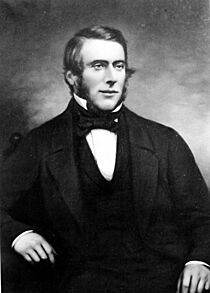
European settlement in Canterbury was greatly helped by brothers William and John Deans in 1843. Their farm in Riccarton Bush showed that the swampy land could be used for farming. The Deans brothers named their farm after their old home in Scotland. They also named the river nearby the Avon, after a river in their homeland.
Captain Joseph Thomas, the Chief Surveyor for the Canterbury Association, mapped the area in 1849 and 1850. He and his assistant, Edward Jollie, planned the simple grid pattern for Christchurch's streets. The First Four Ships brought the "Canterbury Pilgrims" from Britain to Lyttelton Harbour in 1850. These ships were the Randolph, Charlotte Jane, Sir George Seymour, and Cressy. The Charlotte Jane was the first to arrive on 16 December 1850. The Pilgrims wanted to build a city with a cathedral and a college, like Christ Church, Oxford.
Getting between the port at Lyttelton and the new settlement was hard. A steep track, called the Bridle Path, was built over the hills for horses. Heavy goods had to go by sea around the coast and up the Avon Heathcote Estuary to Ferrymead. This journey was often risky. The Sumner Road was finished in 1857, but transport was still a problem. In 1858, the leader William Sefton Moorhouse announced that a tunnel would be dug between Lyttelton and Christchurch. While the tunnel was being built, New Zealand's first public railway, the Ferrymead Railway, opened in 1863.
Christchurch Grows as a Province
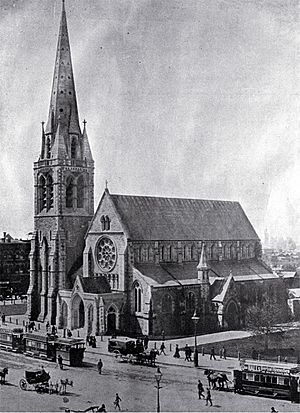
From 1853 to 1876, Christchurch was the main city of the Canterbury Province. The town grew slowly at first, then much faster from 1857 to 1864. Christchurch became New Zealand's first official city on 31 July 1856. By 1874, it was the fourth-largest city in New Zealand. Many stone buildings in the Gothic Revival architecture style, like the Canterbury University College and ChristChurch Cathedral, were built around this time.
Christchurch had some smaller natural disasters too. In 1868, heavy rain caused the Waimakariri River to flood the city. Earthquakes in 1869, 1881, and 1888 damaged buildings. The 1888 earthquake caused the top part of the Christchurch Cathedral spire to fall. In 1901, another earthquake caused the spire to collapse again, but this time it was rebuilt with wood and metal instead of stone.
The Catholic Cathedral of the Blessed Sacrament opened in 1905. In 1906, the New Zealand International Exhibition in Hagley Park attracted over a million visitors. In 1908, a big fire destroyed several buildings in central Christchurch.
In the early 1900s, Christchurch became very industrial, especially in areas like Woolston and Addington. Many factories and railway workshops were built, which made the city's population and economy grow quickly. By 1919, Christchurch had over 100,000 people.
Modern Christchurch: Changes and Challenges
Christchurch grew a lot during the 20th century, partly because many state houses (government-built homes) were constructed. In November 1947, a terrible fire at the Ballantynes department store killed 41 staff members. This led to new building rules to make places safer from fire.
In the 1960s, Christchurch started to spread out, and many shops moved from the city center to new shopping malls in the suburbs. The Lyttelton road tunnel opened in 1964, making it easier to travel between Lyttelton and Christchurch. Television started broadcasting in Christchurch in 1961. In 1969, a one-way street system was set up in the city center to help with traffic.
Christchurch hosted the 1974 British Commonwealth Games at the special Queen Elizabeth II Park sports complex.
Earthquakes of 2010–2011
On 4 September 2010, a strong earthquake hit Christchurch. It caused a lot of damage but no direct deaths. A few months later, on 22 February 2011, another earthquake struck closer to the city. Even though it wasn't as strong in size, it caused very violent shaking, killing 185 people and destroying many buildings. The city center was badly affected. More aftershocks happened in June and December 2011, causing more damage.
Port Hills Fires
In February 2017, two large bush fires started on the Port Hills. They joined together, burning over 2,000 hectares of land and destroying eleven houses. In 2024, another fire on the Port Hills burned 700 hectares. Because of what was learned from the 2017 fire, emergency teams were able to control it more quickly.
2019 Mosque Attacks
On 15 March 2019, a very sad event occurred when 51 people lost their lives in attacks at two mosques, Al Noor Mosque and Linwood Islamic Centre. Many others were injured. This event was a very dark day for New Zealand. The person responsible was later sentenced to life in prison without the chance of parole.
Where is Christchurch? Geography and Landscape
Location and Features
Christchurch is located in the middle of the South Island's east coast, right by the South Pacific Ocean. Most of the city is on flat land, about 20 meters above sea level. The only hills are the Port Hills on Banks Peninsula to the south.
How the Land Was Formed
New Zealand separated from the supercontinent Gondwana about 85 million years ago. Over millions of years, volcanic eruptions created the Banks Peninsula. As the Southern Alps grew, rivers carried gravel over the area, forming the Canterbury Plains. This gravel covers older rock layers.
Underneath Christchurch, there are layers of gravel that hold water, forming an artesian aquifer. This water pressure creates many spring-fed streams. The Avon River and Heathcote River in Christchurch are fed by these springs.
Because of the flat land and spring-fed streams, much of Christchurch was originally a coastal wetland with large swamp forests. Early inhabitants likely burned much of the forest. When European settlers arrived, the area was a mix of swamp and grasslands. Over time, drainage work allowed the city to be built, and now only small parts of the wetlands remain.
The Heart of the City: Central Christchurch
The central part of Christchurch is around Cathedral Square and within the Four Avenues (Bealey, Fitzgerald, Moorhouse, and Deans Avenues). It includes Hagley Park and the Christchurch Botanic Gardens. The city center's grid layout was planned in 1850.
The central city was severely damaged in the 2010 and 2011 earthquakes. Many historic buildings and tall buildings had to be taken down. The Christchurch Central Recovery Plan was created to guide the rebuilding, focusing on new projects and encouraging more people to live in the city center.
Christchurch's Neighborhoods
Christchurch doesn't have official boundaries for its neighborhoods (suburbs). These are usually set by groups like Statistics New Zealand. The first neighborhoods were laid out in a grid pattern around Cathedral Square. The city grew outwards, especially in the 1950s and 60s, with many new homes being built. Places that were once separate towns, like Sumner and New Brighton, eventually became part of the expanding city.
Nearby Towns: Satellite Communities
The wider Christchurch area includes several towns and settlements:
- Leeston
- Lyttelton
- Governors Bay
- Diamond Harbour
- Tai Tapu
- Little River
- Lincoln
- Prebbleton
- Rolleston
- Templeton
- West Melton
- Rangiora
- Woodend
- Waikuku
- Pegasus
- Kaiapoi
- Kainga
- The Pines Beach
- Motukarara
Christchurch Weather: A Temperate Climate
Christchurch has a mild temperate oceanic climate. Summers are generally warm, often cooled by a sea breeze. A unique weather event is the nor'wester, a hot, strong wind that can cause minor damage. The highest temperature ever recorded in Christchurch was 41.6°C in 1973.
In winter, temperatures often drop below 0°C, especially at night. Snow falls about three times a year on average. The lowest temperature recorded was -9.4°C in 1945. On cold winter nights, the city can experience smog because vehicle exhaust and smoke get trapped by a layer of cold air. To help with air pollution, open fires were banned in the city in 2006.
Who Lives in Christchurch? Demographics and Culture
Christchurch City covers about 1,415 square kilometers and has an estimated population of over 391,000 people. It is the second-most populated area run by a single council in New Zealand and the largest city in the South Island.
In the 2023 census, Christchurch City had 391,383 people. The median age was 37.5 years. About 16.5% of people were under 15 years old. Most people (75.9%) identified as European (Pākehā). Other ethnic groups include Māori (11.2%), Asian (17.1%), and Pasifika (4.3%). English is spoken by most people (95.8%).
About 31.6% of people identified as Christian, while 54.9% said they had no religion.
How Christchurch Makes Money: The Economy
Christchurch's Economic Strengths
In 2023, Christchurch City's economy was worth $31.5 billion, which is 8.4% of New Zealand's total economy. The biggest part of Christchurch's economy comes from professional, scientific, and technical services, like engineering and IT. Healthcare and social assistance are also very important. Manufacturing and construction are also big parts of the economy.
Christchurch provides many services for the wider Canterbury Region. While manufacturing and construction are top industries for the whole region, professional services and healthcare are more important within the city itself. Agriculture is still a big part of the Canterbury Region's economy.
Many well-known companies have their main offices in Christchurch, including Macpac (outdoor gear), Kathmandu (clothing), PGG Wrightson (farming supplies), and Tait Communications (radio equipment).
Key Industries in Christchurch
Christchurch is New Zealand's second-largest manufacturing center after Auckland. It used to make things like steel for bridges and tunnels. Now, it mainly produces lighter goods, often for export to Australia. Christchurch was also once a big center for clothing and shoe making, but much of that has moved overseas.
In recent decades, technology companies have grown in Christchurch. Companies like Tait Communications (mobile radios) and those making programming languages like LINC and Jade started here. The University of Canterbury's engineering and computer science departments help provide skilled workers and research for these tech industries. Christchurch is known for its innovative and entrepreneurial tech solutions.
Supporting Agriculture
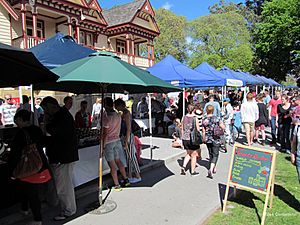
Farming was originally the main part of Christchurch's economy. PGG Wrightson, a leading farming business in New Zealand, is based here. Other farming-related businesses include making malt, developing seeds, processing wool and meat, and using by-products from meat works. Dairy farming has grown a lot in the surrounding areas.
Growing crops like wheat, barley, and seeds for export has always been important in Canterbury. This has led to many processing businesses in Christchurch. The region's agriculture has also become more varied, with a growing wine industry and new types of farming like olive production. Deer farming has also created new products. The local wine industry helps attract tourists to Canterbury and Christchurch.
An important event for the region's agriculture is the Canterbury A&P Show. This big agricultural show, which started in 1862, features farm animals, trade stalls, competitions, and entertainment. The Friday of the show is a public holiday in Christchurch, allowing many people to attend.
Tourism in the Garden City
Tourism is a big part of Christchurch's economy. With a major international airport, Christchurch is a gateway for tourists visiting other South Island attractions like Aoraki / Mount Cook National Park and Queenstown. However, Christchurch is also a destination itself, known for its beautiful gardens, history, museums, and the story of its recovery from the earthquakes. Tourism has grown significantly in Christchurch, with visitors spending a lot on shopping and transport.
Christchurch: Gateway to Antarctica
Christchurch has been a gateway to Antarctica since 1901. Famous explorers like Robert Falcon Scott started their Antarctic journeys from nearby Lyttelton. The International Antarctic Centre in Christchurch provides support facilities for Antarctic missions and also has a museum for visitors to learn about Antarctica. The United States, New Zealand, and Australian air forces use Christchurch Airport as a base for flights to their research stations in Antarctica.
Fun in Christchurch: Culture and Entertainment

Christchurch's buildings often have an English feel, but also include other European styles, especially Gothic Revival architecture. The city also has strong Māori culture influences. There are many public parks, riverside areas, and cafes and restaurants in the city center and surrounding neighborhoods.
Movies in Christchurch
Historically, most movie theaters were located around Cathedral Square. The Hollywood in Sumner, one of the oldest suburban cinemas, operated for many years. Larger movie complexes include Hoyts in Riccarton and Reading Cinemas in The Palms shopping center. The Rialto Cinemas used to show international and art house films but closed after the 2011 earthquake. The Alice Cinema now has two screens and a large collection of unique films. The Canterbury Film Society also holds regular screenings at the Christchurch Art Gallery.
The famous Peter Jackson film Heavenly Creatures (1994), starring Melanie Lynskey and Kate Winslet, was set in Christchurch.
Green Spaces: Parks and Nature

Christchurch is known as The Garden City because of its many public parks and beautiful home gardens. Hagley Park and the 33-hectare Christchurch Botanic Gardens, founded in 1863, are in the city center. These parks are home to native birds like the kererū. Hagley Oval is a popular place for cricket, and other sports like football and rugby are played in Hagley Park. The park also hosts outdoor concerts. North Hagley Park is famous for its cherry blossoms, which bloom beautifully in spring.
Other parks include Rāwhiti Domain in New Brighton and Spencer Park to the north. There are also many smaller parks in the city center, such as Latimer Square and Victoria Square. The Willowbank Wildlife Reserve is north of the city. Travis Wetland is a special area where native plants and birds are being restored. Orana Wildlife Park is New Zealand's only open-range zoo, located just outside Christchurch.
Theater and Performing Arts
Christchurch has a long history of performing arts, with the first theater opening in 1861. The Isaac Theatre Royal, first opened in 1863, has been rebuilt several times and reopened in 2014 after being damaged in the 2011 earthquake.
The Court Theatre is Christchurch's only full-time professional theater, founded in 1971. It moved to a temporary home after the earthquakes, and a new theater is being built in the city center. Other groups like Showbiz Christchurch produce musical theater. There are also many community theater groups that put on shows.
Music Scene
Christchurch is known for its live music, including a professional symphony orchestra. The city also has an experimental music scene. Buskers often perform in the town square, and Christchurch hosts the World Buskers Festival every January. Famous singer-songwriter Hayley Westenra started her international career by busking in Christchurch.
Many New Zealand music acts, like Shapeshifter, Ladi6, and Tiki Taane, are from Christchurch. The city also has a lively drum and bass music scene. In recent years, hip hop has also become popular, with artists like Scribe from Christchurch achieving national success.
Event Venues

The Wolfbrook Arena in Addington is Christchurch's main indoor arena, holding almost 9,000 people for concerts. It's also a home venue for the Mainland Tactix netball team.
The Christchurch Town Hall opened in 1972 and is known for its excellent sound. It reopened in 2019 after being closed for eight years for repairs after the 2011 earthquake.
Christchurch also has a casino and many live music venues. The Piano, a new building, offers various spaces for music and arts performances.
A large convention center called Te Pae opened in 2021, hosting many events. A new multi-purpose covered stadium, Te Kaha, is also being built and is expected to open in 2026.
Sports in Christchurch
Sports have been important in Christchurch since the first British settlers arrived. Cricket and rugby union have been popular team sports for a long time. Today, many other sports are also popular, including netball, touch rugby, and golf.
Christchurch has about 1,200 sports clubs and associations, with over 140,000 members. Most sports are played by amateurs, relying on volunteers. However, there are also professional teams like the Mainland Tactix (netball), Crusaders (rugby), and the Canterbury Kings (cricket).
The city has hosted many international sports events, including the 1974 Commonwealth Games. Christchurch has many outdoor sports grounds and indoor venues. Some older venues, like Lancaster Park and Queen Elizabeth II Park, were damaged in the 2011 earthquake and had to be taken down. New facilities are being built to replace them, including the Ngā Puna Wai Sports Hub and the Parakiore Recreation and Sport Centre.
Learning in Christchurch: Education
High Schools
Christchurch is home to New Zealand's fourth-largest school, Burnside High School, which has over 3,000 students. Other large schools include Cashmere High School, Papanui High School, and Riccarton High School. There are also several single-sex state schools and private church schools, some of which are like traditional English public schools.
Universities and Colleges
Several universities and colleges have campuses in Christchurch:
- Ara Institute of Canterbury
- Lincoln University
- University of Canterbury
- University of Otago, Christchurch
Getting Around Christchurch: Transport
Most people in Christchurch use private cars to get around. The city has a large road network, including several major highways and motorways.
Christchurch has a wide-ranging bus network called Metro, which serves most areas of the city and nearby towns. The main bus routes go through the city center, connecting to the Christchurch Bus Interchange. There's also a special "Orbiter" service that circles the city, connecting suburban shopping areas.
Christchurch has a history as New Zealand's "cycling city." The city is very flat, and the Christchurch City Council has built many cycle paths. After the earthquakes, there was a strong desire to encourage more cycling. The city is building over 100 km of new cycle paths, which has led to a big increase in people cycling. Christchurch is now a national leader in cycling for daily travel.
Trams used to be a main form of public transport in Christchurch, starting in 1880. They stopped running in 1954. In 1995, the Christchurch tramway system was brought back as a tourist attraction. The tram goes around the city center, stopping at places like Cathedral Square and the Arts Centre.
There is also a cable car called the Christchurch Gondola that takes tourists from the Heathcote Valley to the top of Mount Cavendish, offering great views.
Long-distance train services used to run from Christchurch to other parts of New Zealand. Today, the most famous train is the TranzAlpine, which travels through the Southern Alps to Greymouth on the West Coast. This journey is known as one of the world's great train rides because of the amazing scenery.
Christchurch Airport is located northwest of the city center. It's the second-busiest airport in New Zealand, with flights to many places in New Zealand and internationally. The airport is also a major base for Antarctic research programs from New Zealand, the United States, South Korea, and Italy.
City Services: Utilities
Water Supply
Christchurch has one of the best water supplies in the world. Its water is very pure and clean, coming from aquifers (underground water sources) that are naturally filtered. Since 2018, about 70% of the city's water has been temporarily treated with chlorine while upgrades are made to the water system.
Wastewater Treatment
Christchurch was the first city in New Zealand to build an underground sewer system. In the 1870s, many people were getting sick from diseases like typhoid because waste was going into the rivers. A drainage board was set up in 1876. In 1878, an engineer designed a sewer network that pumped waste to sandhills for irrigation. The first sewage pumping station opened in 1882. After the system was built, Christchurch became a much healthier city.
Electricity
The Christchurch City Council started the city's first public electricity supply in 1903. In 1914, Christchurch was connected to the Coleridge Power Station. Today, a company called Orion New Zealand owns and operates the electricity network in the city. The 2011 earthquakes caused a lot of damage to the electricity network, requiring major repairs and new infrastructure. In 2013, most homes in Christchurch used electricity for heating.
Telecommunications
Telephone service began in Christchurch in 1881. Mobile phone service was introduced in 1988. In the 2010s, high-speed fiber optic internet was installed across Christchurch, making internet connections much faster.
News and Media in Christchurch
The main daily newspaper in Christchurch is The Press. It has been published since 1861. Another weekly newspaper is The Star.
Christchurch has the second-largest radio market in New Zealand. Popular radio stations include Newstalk ZB, More FM, and The Breeze. Most radio stations in Christchurch are broadcast from Auckland.
Television started in Christchurch on 1 June 1961 with channel CHTV3. This channel is now part of Television New Zealand. Like radio, most television channels in Christchurch are broadcast from Auckland.
Christchurch's Sister Cities
Christchurch has special "sister city" relationships with other cities around the world to promote friendship and understanding:
- Adelaide, Australia (since 1972)
- Christchurch, England, United Kingdom (since 1972)
- Kurashiki, Japan (since 1973)
- Seattle, United States (since 1981)
- Songpa-gu, South Korea (since 1995)
- Wuhan, China (since 2006)
Christchurch also has friendly relations with Gansu in China.
See also
 In Spanish: Christchurch para niños
In Spanish: Christchurch para niños







